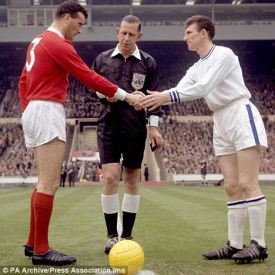Being the football referee enthusiast that I am, and a self proclaimed nerd when it comes to things of this nature, I am often left wondering about situations and their probability of actually coming to pass, not just in my own appointments, but in games my friends watch over or matches I see on TV. I also like to ponder on the reasons why certain things are the way they are, and how/when they came to be. Often these two curiosities work hand in hand as finding the answer to one, inevitably answers the other. Over the weekend, a friend asked a hypothetical scenario which did exactly that; the answer sparked my wonder and I went searching for answers.(I should preface the question by saying that DMC knows the answer but was just thinking about the mechanics and complexity of the situation.)
The scenario as asked by DMC goes like this:
“Player commits cautionable offence (doesn’t matter what it is really – but let’s say a reckless tackle). You take out your pad/card to write it down before showing the yellow. Player smacks said pad/card out of your hand – You show a red card for that.Question: Do you still record the yellow you were going to give? If so, when do you consider the caution “recorded”? When the act is committed that warrants the caution, when you decide in your head you’re giving a caution, or when you show/write the caution (whichever comes first)?”
The short answer to this is YES – you record the caution, in addition the the send-off/red.
The long answer – you record both the caution and the send-off, and you report them both to the appropriate authorities. Look at it this way – it’s the same as if a cautionable offence occurred in the first half, for which you have cautioned blue #10, and then in the second half blue #10 punches an opponent and you send him off for VC. In this case, you report both the caution and the send off separately to the proper authority. The only difference here is that in DMC’s question the send-off offence happens right after the caution and just before you show the yellow card. The only instance where you wouldn’t report a caution separately from a send-off is in the case where a player is sent-off for receiving a second caution in the same match. In this case, you send in only one send-off report however, you describe both caution incidences within your report.
So, what do you actually do in this case? As you reach into your back pocket for your red card (because you do carry more than one set of cards at all times, like a good little official, right?), you verbally tell the player “# whatever, you’ve been cautioned for that reckless tackle, and now you’re being sent off for this stupidity!” There is no need to physically show the yellow card, and show only the red card and get on with the rest of the game.
Showing a yellow card and then immediately showing a red would confuse everyone, making them think that the player was sent off for receiving a second caution in the same match. In any case, physically showing a yellow card is not mandatory as per LOTG. (This is where the second part of the fun comes in).
What? You can caution or send off a player without actually showing a card? YES!!!! The use of the cards are only as a visual aid – for EVERYONE to see that a player is being cautioned or sent off, and so that there is no question as to the referee’s intent and decision. Believe it or not, there was a time where cards did not exist! The use of disciplinary cards (yellow/red cards) were not always a part of football and the LOTG. The yellow and red cards, as we know them today were actually “invented” 45 years ago by Ken Aston, an Englishman who sadly passed away in October 2001.
In 1966, hosts England met Argentina in the quarter-final at Wembley, and Aston, who was in charge of refereeing at the tournament, had to use all of his diplomacy and powers of persuasion to calm down the Argentine captain Rattín after his sending off, and to prevent the match being abandoned. The controversial game also took on greater significance when match reports in newspapers claimed that the referee had booked both Charlton brothers, Bobby and Jack. Apparently, the referee had not indicated this publicly, and England manager Alf Ramsey approached FIFA for clarification. It started a train of thought in Aston’s head too. He began to think about ways to avoid such problems in the future. “As I drove down Kensington High Street, the traffic light turned red. I thought, ‘Yellow, take it easy; red, stop, you’re off’.”
With that, yellow and red cards were introduced at the 1970 FIFA World Cup™ in Mexico, and have since become part and parcel of the game.
Happy Whistling!
The Third Blind Mouse



